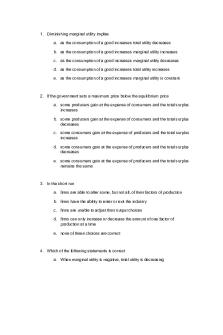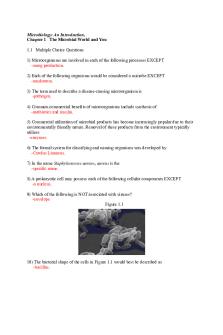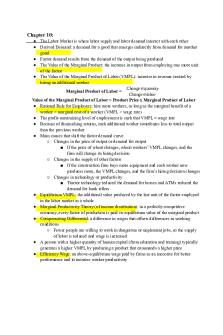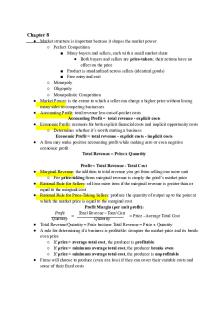Micro #2 - Lecture notes PDF

| Title | Micro #2 - Lecture notes |
|---|---|
| Course | Intro to Microeconomics |
| Institution | Tulane University |
| Pages | 19 |
| File Size | 304.6 KB |
| File Type | |
| Total Downloads | 6 |
| Total Views | 170 |
Summary
Lecture notes...
Description
1. Diminishing marginal utility implies a. as the consumption of a good increases total utility decreases b. as the consumption of a good increases marginal utility increases c. as the consumption of a good increases marginal utility decreases d. as the consumption of a good increases total utility increases e. as the consumption of a good increases marginal utility is constant
2. If the government sets a maximum price below the equilibrium price a. some producers gain at the expense of consumers and the total surplus increases b. some producers gain at the expense of consumers and the total surplus decreases c. some consumers gain at the expense of producers and the total surplus increases d. some consumers gain at the expense of producers and the total surplus decreases e. some consumers gain at the expense of producers and the total surplus remains the same
3. In the short run a. firms are able to alter some, but not all, of their factors of production b. firms have the ability to enter or exit the industry c. firms are unable to adjust their output choices d. firms can only increase or decrease the amount of one factor of production at a time e. none of these choices are correct
4. Which of the following statements is correct a. When marginal utility is negative, total utility is decreasing
b. when marginal utility is positive and increasing, total utility is increasing at an increasing rate c. when marginal utility is positive and decreasing, total utility is decreasing at an increasing rate d. when total utility is increasing at a decreasing rate, marginal utility is negative e. Answers a and b are correct
5. Assume the government sets a minimum price for a particular good below the equilibrium price. How much quantity traded will this lead to? a. below the equilibrium quantity b. above the equilibrium quantity c. it depends upon how far below the equilibrium price the government sets the minimum price d. none of these answers are correct e. at the equilibrium quantity
Questions #6, #7 and #8 refer to the picture below – a market before and after a sales tax has been levied
P($)
New supply with $2
tax
Initial Supply
D
Q/time
6. The consumer surplus at the initial equilibrium is shown by area(s) _______. a. A + B b. D + E c. F + E + G d. A + B + C + D e. A + B + C + F + G
7. After the tax has been levied, the producer surplus is shown by areas _____. a. F + G b. E + F + G c. A + B + C + F + G d. G e. B + C + F
8. After the tax has been levied, the tax revenue is shown by area(s) _____ and the dead weight loss is shown by are(s) ______. a. F; E b. B + C; D + E c. F + G; D + E d. B + C + F; D + E e. B + C; D
S
$3 $2
D
$1
Q/time 10
13
16
9. Referring to the graph above, which of the following statements is correct a. The quantity demanded when the price is $3 is 10 units and the marginal cost when the price is $1 is 10 units b. The quantity supplied when the price is $1 is 16 units and the marginal cost of the 16th unit is $3 c. At a price of $3, the marginal cost is greater than the marginal benefit d. The quantity demanded at $1 is 16 units and the marginal cost of the 16th unit is $3 e. At 10 units, the quantity supplied is less than the quantity demanded
10. Which of the following statements about a consumer’s indifference curve is correct? I.
Indifference curves are negatively sloped
II.
The marginal rate of substitution (in absolute value) becomes smaller as you move down and to the right along an indifference curve
III.
Indifference curves never intersect
IV.
The slope of an indifference curve at any point is equal to the price of the good on the x-axis divided by the price of the good on the y-axis
a. I, II and III only b. I and III only c. II, III and IV only d. I and IV only e. I, II, III and IV
11. If Tova gets 80 utils from consuming five cookies, 100 utils from consuming six cookies and 120 utils from consuming seven cookies, then Tova’s marginal utility from the sixth cookie is a. 20 utils b. 80 utils c. 100 utils d. 120 utils e. 40 utils
12. Diminishing marginal returns implies that firms a. require fewer and fewer workers to produce each additional unit of output b. get decreasing amounts of revenue for each unit of output produced c. get increasing amounts of revenue for each unit of output they produce d. total cost will increase as output increases e. require more and more workers to produce each additional unit of output 13. Suppose the price of Oreos is $4 a package and the price of a coke is $1. Suppose Gerhardt is spending his money efficiently and his marginal utility of the last package of Oreos is 60 utils then we know a. that his marginal utility of his last coke is 15 utils b. that his marginal utility of his last coke is also 60 utils c. that his marginal utility of his last coke must be less than 30 utils but more than 20 utils d. that his marginal utility of his last coke must be more than 30 utils but less than 60 utils e. he is buying the same number of packages of Oreos as cans of coke
14. Suppose that we draw Jordan’s demand curve for books using her budget line and indifference curves for movies and books. Which of the following variables is held fixed? I.
Jordan’s preferences for the two goods
II.
The price of movies
III.
The price of books
IV.
Jordan’s income
a. I and II only b. I, II and IV only c. II, III and IV only d. II and III only e. I, II, III and IV
Use the graph below to answer the next two questions Q of Cookies/time
Q of Apples/time
15. Which of the following preference rankings is consistent with the points on the graph? a. C is preferred to B, which is preferred to A b. D is preferred to B, which is equivalent in utility to C c. D is preferred to A, which is equivalent in utility terms to C d. A is preferred to B, which is preferred to D e. D is preferred to C, which is preferred to B 16. The marginal rate of substitution (in absolute value) is ______ the slope of the budget line (in absolute value) at point A; _____ the slope of the budget line at point B; and _____ the slope of the budget line at point C. a. less than; equal to; greater than b. greater than; equal to; less than c. greater than; less than; equal to d. equal to; less than; greater than e. less than; greater than; equal to Number of Workers
Total Product
0
0
1
10
2
30
3
44
4
55
17. According to the table above, diminishing marginal returns set in with the addition of the _____ worker and average product is ______ for the second worker. a. first; 10 units b. second; 10 units c. third; 15 units d. fourth; 13.75 units e. third; 13.75 units
18. The shape of an indifference curve between perfect substitutes will be a. a straight line b. like all other indifference curves c. upward sloping d. zig-zag e. a right angle
19. If a sales tax is imposed on restaurant meals, a. more meals will be produced and sold b. the government’s tax revenue will fall c. fewer meals will be produced and sold d. the market price of meals will decrease e. restaurants will sell more meals, but at a lower price per meal
20. If !
MUw a te r MUs o d a > then the consumer should P so d a P w a ter a. consume more of water and less soda b. consume less of water and more soda c. consume less of both water and soda d. not change the consumption levels of either water or soda e. consume more coffee
21. A market is said to be allocatively efficient if a. MB = MC b. QD = QS c. the amount produced is a point on the PPF d. consumer surplus is less than producer surplus e. consumer surplus is equal to producer surplus
22. When a sales tax is imposed a. consumer surplus will likely increase b. consumer surplus will likely decrease c. producer surplus will likely increase d. producer surplus will likely decrease e. both b and d 23. A price floor is designed to help the _______ because it causes consumer surplus to _____ and producer surplus to _____. a. demander; increase; decrease b. supplier; increase; decrease c. demander; decrease; increase d. supplier; decrease; increase e. supplier; increase; increase 24. If a Tova’s income rises, her a. budget line shifts inward b. budget line shifts outward c. indifference curve shifts inward d. indifference curve shifts outward e. budget line becomes steeper. 25. A demand curve answers the question “how much would a demander be willing and able to buy at various prices?”; a marginal benefit curve answers a. the same question b. the question “how much would a producer be willing and able to sell at various prices?” c. the question “how much would a demander be willing to pay for one more unit of a good?” d. the question “how much would a supplier be willing to charge for one more unit of a good?” e. the question “what is the total utility of consuming a certain number of units of a good?”
26. An indifference curve represents a. the combination of two goods that make a consumer equally well off b. the relationship between the price of a good and the quantity demanded c. the relationship between price and utility d. combinations of goods that could be purchased with the same level of income e. the total output resulting from various combinations of inputs
27. The price of a burrito is $7.50 each, and the price of a pizza is $15.00 each. If Gerhardt were to graph his budget line with quantity of pizza per month on the horizontal axis and quantity of burritos on the vertical axis, the absolute value of the slope of the budget line would be a. 2 b. ½ c. ¼ d. 4 e. without Gerhardt’s income it is impossible to figure out
Price $9
S
$8 $7 $6 $5 $4 $3 $2 $1
D
$0
!
0
1
2
3
4
5
6
7
8 Q/time
28. Using the graph above, the marginal benefit of the second unit is ____ and the marginal cost of the second unit is ______ a. $8; $2 b. $4.5; $4.5 c. $7; $2 d. $1; $6 e. $2; $7
Quantity of Labor
Tons of Coal Mined
1
80
2
180
3
300
4
480
5
555
29. The table above shows the amounts of coal that a mining company could produce per week by changing the number of workers while capital and technology remain constant. The marginal product of employing the fourth worker is a. 120 tons of coal b. 480 tons of coal c. 319 tons of coal d. 180 tons of coal e. 106.33 tons of coal 30. The change in total utility arising from a one-unit increase in consumption of a good is referred to as a. average utility b. the principle of diminishing marginal utility c. real income d. marginal utility e. price
31. Indifference curves have all of the following characteristics, except one. Which one is the exception? a. they have a negative slope b. total utility is constant along each curve c. they do not cross each other d. curves that are father from the origin are preferred to those closer to the origin e. they are usually straight
32. If the physical plant for a corporation is considered to be a fixed input, then a. it is held constant in the long run b. it can be changed in the long run c. labor must be a variable input d. technology must be changing e. the firm will lose money in the short run, except under certain conditions
33. If a firm is experiencing diminishing marginal returns to labor, then a. total output must be decreasing b. total output rises more slowly as additional workers are added c. the firm must decrease the amount of labor it hires d. output per worker must be rising e. total fixed costs must be increasing Quantity of Good B/time 15 14 13 12 11 10 9 8 7 6 5 4 3 2 1 0
Y = $140.00
0
!
1
2
3
4
5
6
7
8
9
10
11
Quantity of Good A/time
34. Using the graph above, when the price of Good B is $10.00 what is the quantity demanded of Good B? a. 14 units b. 7 units c. 10 units d. 5 units e. more information is required to answer this question 35. Using the graph above, when the price of Good B is $20.00 what is the quantity demanded of Good A? a. 3 units b. 7 units c. 10 units d. 5 units e. more information is required to answer this question 36. Amos owns a computer repair shop called, Amos’s Computer Repair Shop. Which of the following is most variable factor of production? a. The storefront in which the business is located b. The office furniture c. The common office supplies such as pens, pencils and paper d. The number of DSL lines coming into the shop e. The number of full-time salaried employees
37. In the short run a. firms are able to alter some, but not all, of their factors of production b. firms have the ability to enter or exit the industry c. firms are unable to adjust their output choices d. firms can only increase or decrease the amount of one factor of production at a time e. none of these choices are correct
38. Which of the following is true? a. b.
AT ! C = AVC − A FC ∆ AVC ∆ TC = ∆Q ∆Q !
c.
d. !
!
∆ T VC = MC ∆Q
T VC T C T FC + = Q Q Q
e. All of these choices are correct
39. Ezra decides to start his own business. He quits his job in which he was earning $40,000 a year. He kicks the tenants, who were paying $20,000 a year rent, out of his building so he can use it for his business. And he withdraws $100,000 that was earning 6% interest out of the bank to invest in his business. The supplies cost him $75,000 and his labor costs are $25,000. In this situation, Ezra’s explicit costs of production are ____ and his implicit costs of production are _____ a. $100,000; $100,000 b. $100,000; $66,000 c. $100,000; $166,000 d. $66,000; $66,000 e. $100,000; $266,000
40. The marginal cost curve intersects the short-run average total cost curve where a. average variable costs are maximized in the short run b. average total costs are minimized in the short run c. marginal cost is minimized in the short run d. average variable costs are minimized in the short run e. average product is maximized in the short run
41. Diminishing marginal returns implies that firms a. require fewer and fewer workers to produce each additional unit of output b. get decreasing amounts of revenue for each unit of output produced c. get increasing amounts of revenue for each unit of output they produce d. total cost will increase as output increases e. require more and more workers to produce each additional unit of output
42. When does a firm’s average variable cost exceed the average total cost? a. When the average variable cost is at its minimum b. Never c. When the average total cost equals the average fixed cost d. When the average fixed cost is at its minimum e. When total cost is at its maximum
43. Other things being equal, if a firm’s marginal cost curve shifts upward at all output levels, a. the average variable cost curve remains unchanged at all output levels b. the total cost curve remains unchanged at all output levels c. the average total cost curve remains unchanged at all output levels d. the average fixed cost curve remains unchanged at all output levels e. all of the above
44. Marginal cost is a. the increase in total cost from producing one more unit of output b. total variable cost per unit of output c. fixed cost per marginal unit d. average total cost divided by the quantity of inputs used e. total cost per unit of output
Use the table below to answer questions #45 and #46 # of Labor
TP
MP
AP
TFC
TVC
TC
1
4
4
4
$30
$40
$70
2
9
5
4.5
$30
$80
$110
3
12
3
4
$30
$120
$150
4
13
1
3.25
$30
$160
$190
45. What is the Marginal Cost of the 12th unit? a. $40 b. $50 c. $13.33 d. $3.33 e. $10
46. What is the Average Variable Cost of the 13th unit? a. $40 b. $12.31 c. $13.33 d. $3.33 e. $10
47. Ezra owns a garage called Ezra’s Garage. Which of the following is most likely to be a fixed input in the short run for Ezra’s Garage? a. the grease used to lubricate cars b. the part-time labor employed to repair cars c. the inventory of replacement parts d. the electricity used to heat and light the garage e. the garage used to repair cars
48. A sunk cost is one that a. changes as the level of output changes in the short run b. was paid in the past and will not change regardless of later decisions c. should determine the rational course of action in the future d. has the most impact on profit-maximizing decisions e. influences rational decision makers
49. Which of the following formulas is not correct? a.
AT ! C = AVC +
b.
!T VC =
c.
T FC ( Q )
TC Q
! T C = T FC + T VC T FC Q
d.
!A FC =
e.
!T VC = AVC*Q
Quantity of Labor
Tons of Coal Mined
1
80
2
180
3
300
4
480
5
555
50. The table above shows the amounts of coal that a mining company could produce per week by changing the number of workers while capital and technology remain constant. The marginal product of employing the fourth worker is a. 120 tons of coal b. 480 tons of coal c. 319 tons of coal d. 180 tons of coal e. 106.33 tons of coal 51. Over the range of output in which Marginal Product is increasing a. Marginal Cost will be increasing b. Average Variable cost will be increasing c. Total Product will be increasing at a decreasing rate d. Total Cost will be increasing at a decreasing rate e. Average Fixed Cost will be constant
52. If the physical plant for a corporation is considered to be a fixed input, then a. it is held constant in the long run b. it can be changed in the long run c. labor must be a variable input d. technology must be changing e. the firm will lose money in the short run, except under certain conditions
53. If a firm is experiencing diminishing marginal returns to labor, then a. total output must be decreasing b. total output rises more slowly as additional workers are added c. the firm must decrease the amount of labor it hires d. output per worker must be rising e. total fixed costs must be increasing
54. The vertical distance between a firm’s total cost curve and its variable cost curve a. is zero b. is negative when the firm incurs fixed costs in the short run c. represents total fixed costs d. represent marginal costs e. represent average fixed costs
55. Which of the following is true about the relationships among various cost curves? a. When MC exceeds ATC, ATC must be rising. b. When MC exceeds ATC, ATC could be...
Similar Free PDFs

Micro #2 - Lecture notes
- 19 Pages

Micro 2 - Lecture notes 2
- 18 Pages

Chapter 4 - Micro - Lecture notes 4
- 10 Pages

Chapter 4 Micro - Lecture notes 4
- 11 Pages

Lesson 3 micro - Lecture notes 3
- 2 Pages

Micro Ch 1 - Lecture notes Ch 1
- 5 Pages

Micro Lab Quiz 1 - Lecture notes 1
- 14 Pages
Popular Institutions
- Tinajero National High School - Annex
- Politeknik Caltex Riau
- Yokohama City University
- SGT University
- University of Al-Qadisiyah
- Divine Word College of Vigan
- Techniek College Rotterdam
- Universidade de Santiago
- Universiti Teknologi MARA Cawangan Johor Kampus Pasir Gudang
- Poltekkes Kemenkes Yogyakarta
- Baguio City National High School
- Colegio san marcos
- preparatoria uno
- Centro de Bachillerato Tecnológico Industrial y de Servicios No. 107
- Dalian Maritime University
- Quang Trung Secondary School
- Colegio Tecnológico en Informática
- Corporación Regional de Educación Superior
- Grupo CEDVA
- Dar Al Uloom University
- Centro de Estudios Preuniversitarios de la Universidad Nacional de Ingeniería
- 上智大学
- Aakash International School, Nuna Majara
- San Felipe Neri Catholic School
- Kang Chiao International School - New Taipei City
- Misamis Occidental National High School
- Institución Educativa Escuela Normal Juan Ladrilleros
- Kolehiyo ng Pantukan
- Batanes State College
- Instituto Continental
- Sekolah Menengah Kejuruan Kesehatan Kaltara (Tarakan)
- Colegio de La Inmaculada Concepcion - Cebu








